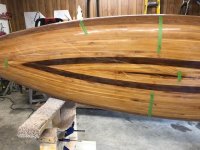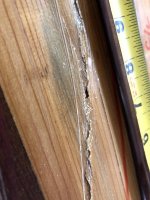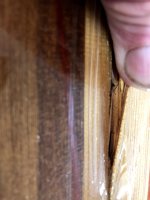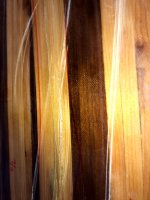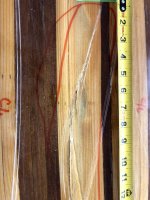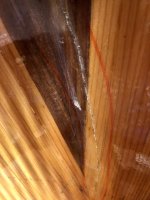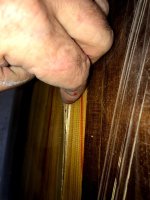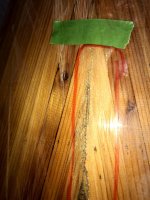This past weekend I got a little over confident and put my stripper, the Evy Dee, on a river that had a little more whitewater than expected. Long story short, we ended up splitting the hull. No holes just a long crack through the glass and wood on the bottom. Two questions 1) what would be the best way to fix this (thinking of removing the cracked wood, butt splicing in a piece and glassing over on outside and inside) and 2) any suggestions on a bottom cover that would allow a few rocks on a river( originally used 6 oz cloth and two additional coats of resin on outside and 6 oz and one additional coat on inside)? Thanks in advance
-
Happy Birthday, Simon Fraser (1776-1862)! 🧭🏞 4️⃣9️⃣
You are using an out of date browser. It may not display this or other websites correctly.
You should upgrade or use an alternative browser.
You should upgrade or use an alternative browser.
repair advice
- Thread starter PMinNC
- Start date
Pics sure would help !
After my first few builds, I started double layering the outside, up to about the 3" waterline. This adds stiffness, as well as weight, but in my book worth it !
Depending on how bad the wood is broken up ? If it still holds the original shape ? I'd sand the outside, again to about the 3" waterline, and cover with 6 oz S-glass.' Fill the weave properly of course.
On the inside I'd sand around the cracks and add the Left over 6 oz S-glass over them.
You could also sand the crack plus a few inches either side, and patch. That would be the quick fix method.
Obviously I'd go with the first.
The Split hull reminds me of a good Friend that bragged how Light his hull was ! We used Duct tape to get him out of the BWCA , a few days early one year. A split down the middle also .
Jim
After my first few builds, I started double layering the outside, up to about the 3" waterline. This adds stiffness, as well as weight, but in my book worth it !
Depending on how bad the wood is broken up ? If it still holds the original shape ? I'd sand the outside, again to about the 3" waterline, and cover with 6 oz S-glass.' Fill the weave properly of course.
On the inside I'd sand around the cracks and add the Left over 6 oz S-glass over them.
You could also sand the crack plus a few inches either side, and patch. That would be the quick fix method.
Obviously I'd go with the first.
The Split hull reminds me of a good Friend that bragged how Light his hull was ! We used Duct tape to get him out of the BWCA , a few days early one year. A split down the middle also .
Jim
Was the split on the inner hull or the outer? Like Jim, I double layer all the bottoms of my canoes, they have seen a lot of white water, and have needed occasional work, but no catastrophic failures yet, lol.
I had built a DY Special that weighed 32 lbs...after many years of abuse, it split right up the keel line on the inside. I dried it out for a week or so, and glassed a full length with some 2" wide 10 oz tape. It looked as if it were a design feature!!
For your split, definitely give it a while to dry out, even if you think it didn't soak up anything. If your wood is splintered, cut it out and replace it. I have had many patches on my hulls, it doesn't even matter that they are obvious and prominent...Remember, every scar tells a story. Eventually, your boat will be a veritable scrapbook of memories.
And yes, nearly every hull I have is built with 1-1/2 layers both inside and outside. If you're really rough on the boat, with beachings and rocky landings, then add some Dynel near the stems for abrasion resistance. Maybe add a half layer in and out, and you should be good for many years to come.
I did have one catastrophic failure, but that was a wrap in some easy Class II and a tired boat. It was a fitting end, after all, it's better to burn out than to fade away.
For your split, definitely give it a while to dry out, even if you think it didn't soak up anything. If your wood is splintered, cut it out and replace it. I have had many patches on my hulls, it doesn't even matter that they are obvious and prominent...Remember, every scar tells a story. Eventually, your boat will be a veritable scrapbook of memories.
And yes, nearly every hull I have is built with 1-1/2 layers both inside and outside. If you're really rough on the boat, with beachings and rocky landings, then add some Dynel near the stems for abrasion resistance. Maybe add a half layer in and out, and you should be good for many years to come.
I did have one catastrophic failure, but that was a wrap in some easy Class II and a tired boat. It was a fitting end, after all, it's better to burn out than to fade away.
I agree with those guys. I have a few short lengthwise splits on my strip canoe that only seem to have affected the inside glass. If that's the case with yours, just let them dry out, lay down some epoxy and put a couple strips of glass on the inside over the splits. That should take care of it. If the fiberglass is compromised on the outside too and if you plan on doing more river trips I might put a layer of 4 oz S-glass over the bottom football area. The s-glass I get is 30" wide. Here's a link to what I use on all the boats I've built.
https://compositeenvisions.com/fibe...m-3-6oz-123-gsm-hexcel-style-4522-f81-finish/
S-glass is stronger and a bit more abrasion resistant than regular e-glass.
Mark
https://compositeenvisions.com/fibe...m-3-6oz-123-gsm-hexcel-style-4522-f81-finish/
S-glass is stronger and a bit more abrasion resistant than regular e-glass.
Mark
"No holes just a long crack through the glass and wood on the bottom."
I'm curious as to whether the damage was related to strip layup in any way, or rather, general area damage involving adjacent strips? And more specifically, if related to strip layout, was it at or near the keel line? The reason I ask is that I'm starting my first build and keying in to construction details I never thought of before. One thing I've noticed is that there seems to be two ways to "close" the bottom of the canoe. The one I see most often is stripping past centerline, cutting centerline, and then stripping/fitting back to it ("Canoecraft"). The other is working both sides of the boat alternately toward center, with herringbone type joints at each end ("Gilpatrick's book"). The carpenter in me likes Gilpatrick's staggered joints, but there must be a reason most builders seem to use the Canoecraft method.
If this is thread drift I could delete and start a new thread?
I'm curious as to whether the damage was related to strip layup in any way, or rather, general area damage involving adjacent strips? And more specifically, if related to strip layout, was it at or near the keel line? The reason I ask is that I'm starting my first build and keying in to construction details I never thought of before. One thing I've noticed is that there seems to be two ways to "close" the bottom of the canoe. The one I see most often is stripping past centerline, cutting centerline, and then stripping/fitting back to it ("Canoecraft"). The other is working both sides of the boat alternately toward center, with herringbone type joints at each end ("Gilpatrick's book"). The carpenter in me likes Gilpatrick's staggered joints, but there must be a reason most builders seem to use the Canoecraft method.
If this is thread drift I could delete and start a new thread?
SG, I seem to remember a post about that a long while back. I thought pretty epic at the time!
My cracks were between strips, not at the centerline. I used a herringbone on that first canoe, but it doesn't really matter which method you use because both result in parallel strips in the very center of the boat. On close inspection the cracks were actually right next to the glue line, not on it. Meaning that the glue and epoxy joint was stronger than the wood, which is typical with making anything with wood. In the end, I think the canoecraft method is easier and faster, which is why I use it now.
Mark
Mark
Here are some pics of the damage.
Attachments
Wow, you really did a number on that!!
Yes, any glass can go over any other glass, and West (or any other, less costly epoxy) resin will work with S-glass, or E-glass, or Dynel, or Vectran, or, well, you get the idea.
I should mention that what you have is a pretty severe failure.
The outside of your hull needs to protect from abrasion, and under most typical loads is in compression. The inside of your hull under those loads is under tension. The engineering behind composite structures says to put the highest strength laminate on the INSIDE, and the highest abrasion resistant laminate on the OUTSIDE. A double layer below the waterline on both the inside and outside is generally adequate.
Definitely cut out the damaged and water stained wood, whether or not you try to make that replacement wood invisible or obvious is up to you. As I said before, every scar tells a story.
Yes, any glass can go over any other glass, and West (or any other, less costly epoxy) resin will work with S-glass, or E-glass, or Dynel, or Vectran, or, well, you get the idea.
I should mention that what you have is a pretty severe failure.
The outside of your hull needs to protect from abrasion, and under most typical loads is in compression. The inside of your hull under those loads is under tension. The engineering behind composite structures says to put the highest strength laminate on the INSIDE, and the highest abrasion resistant laminate on the OUTSIDE. A double layer below the waterline on both the inside and outside is generally adequate.
Definitely cut out the damaged and water stained wood, whether or not you try to make that replacement wood invisible or obvious is up to you. As I said before, every scar tells a story.
I'd sand the cloth back aways, say a couple of inches beyond the crack. Flip the hull, bottom side up. But first apply tape on the inside.
Here's a trick, I just picked up from a member of our wood shop ! Use Aluminum Duct tape ! This stuff is real sticky ! And will stop the resin from seeping through ,the other side of the hull. It comes off good, when you want it to.
You can get by mixing epoxy and filler, instead of removing any wood. Work it into the crack. S-glass if you can get it ! But E-glass should be fine. Two layers on both sides plus the epoxy/filler should be plenty !
I'd add two layers of cloth that is about an inch or two beyond the sanding , the widest one first. Epoxy enough coats, to fill the weave, after it sets ? Feather the cloth edges. .
Flip and do the same to the inside ! No need for tape this time..
Sand and varnish.
If the wood is all there, and not rotted, I see no need to remove it. You may need to weight the hull to proper shape, if distorted
I'd bet it would be near invisible when done.
Good Luck !
Jim
Here's a trick, I just picked up from a member of our wood shop ! Use Aluminum Duct tape ! This stuff is real sticky ! And will stop the resin from seeping through ,the other side of the hull. It comes off good, when you want it to.
You can get by mixing epoxy and filler, instead of removing any wood. Work it into the crack. S-glass if you can get it ! But E-glass should be fine. Two layers on both sides plus the epoxy/filler should be plenty !
I'd add two layers of cloth that is about an inch or two beyond the sanding , the widest one first. Epoxy enough coats, to fill the weave, after it sets ? Feather the cloth edges. .
Flip and do the same to the inside ! No need for tape this time..
Sand and varnish.
If the wood is all there, and not rotted, I see no need to remove it. You may need to weight the hull to proper shape, if distorted
I'd bet it would be near invisible when done.
Good Luck !
Jim
Canoes are made to be used. 6 ounce cloth is fairly light. After you get the wood repaired I would add a layer of glass on the bottom. It could be dynel, kevlar, or some other strong material. Sometimes it is just best to take a Royalex boat and save the wood boats for better flows.
Similar threads
- Replies
- 15
- Views
- 1K
- Replies
- 7
- Views
- 1K
- Replies
- 31
- Views
- 4K
- Replies
- 73
- Views
- 7K

